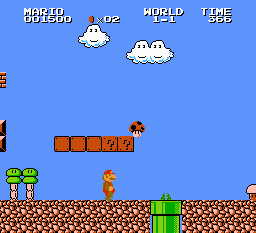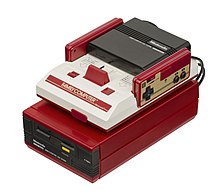Super Mario Bros.: The Lost Levels
| Super Mario Bros.: The Lost Levels | |
|---|---|
Platform game | |
| Mode(s) | Single-player |
Super Mario Bros.: The Lost Levels (originally Super Mario Bros. 2,
The Lost Levels is similar to its predecessor in style and gameplay, with players controlling
Reviewers viewed The Lost Levels as an extension of the previous game, especially its difficulty progression. Journalists appreciated the game's challenge when spectating
Gameplay

The Lost Levels is a 2D
The Lost Levels continues the difficulty progression from Super Mario Bros.
Development
The original Super Mario Bros. was released in North America in October 1985. When developing a version of the game for Nintendo's
The Lost Levels, originally released in Japan as Super Mario Bros. 2
As I continued to play, I found that Super Mario Bros. 2 asked me again and again to take a leap of faith, and each of those leaps resulted in my immediate death. This was not a fun game to play. It was punishment – undeserved punishment. I put down my controller, astonished that Mr. Miyamoto had chosen to design such a painful game.
When evaluated for release outside of Japan,
Nintendo instead released a retrofitted version of Fujisankei Communications Group's Doki Doki Panic as the region's Super Mario Bros. 2 in October 1988.[15] Doki Doki Panic had originally been developed by Kensuke Tanabe. Tanabe was instructed to use characters from Yūme Kojo '87 and was released in Japan as a standalone game on July 10, 1987. Doki Doki Panic's characters and artwork were modified to match Super Mario Bros. before being released in America, and the re-skinned release became known as the "big aberration" in the Super Mario series.[3] The American Super Mario Bros. 2 was later released in Japan as Super Mario USA.[15]
Rereleases

Nintendo "cleaned up" parts of the Japanese Super Mario Bros. 2 and released it in later Super Mario collections as The Lost Levels.
Nintendo's
Reception and legacy
| Publication | Score |
|---|---|
Nintendo Life | Wii U: |
At the time of its release, The Lost Levels topped Famicom Tsūshin's charts.[11] The game was the most popular game on the Disk System, for which it sold about 2.5 million copies.[1] Retrospective critics viewed The Lost Levels as an expansion of the original,[2][1][5][6] akin to extra challenge levels tacked on its end.[2] Despite their similarities, the sequel is distinguished by its notorious difficulty.[20] 1001 Video Games You Must Play Before You Die summarized the game as both "familiar and mysterious" and "simply rather unfair".[8] The Lost Levels replaced the original's accessible level designs with "insanely tough obstacle courses"[3] as if designed to intentionally frustrate and punish players beginning with its first poison mushroom.[26][20][2]
Retrospective reviewers recommended the game for those who mastered the original, or those who would appreciate a painful challenge.
The Lost Levels is remembered among the most difficult games by Nintendo and in the video game medium.
Luigi received his first distinctive character traits in The Lost Levels: less ground friction, and the ability to jump farther.
Notes
References
- ^ a b c d "Super Mario Bros. 2". Atari HQ. May 4, 1999. Archived from the original on March 11, 2015. Retrieved April 1, 2015.
- ^ a b c d e f g h i j k l m n o p Thomas, Lucas M. (October 3, 2007). "Super Mario Bros.: The Lost Levels Review". IGN. Archived from the original on May 16, 2022. Retrieved June 2, 2022.
- ^ a b c d e f g h i j k l McLaughlin, Rus (September 13, 2010). "IGN Presents: The History of Super Mario Bros". IGN. Archived from the original on March 20, 2022. Retrieved June 1, 2022.
- ^ a b c d Farokhmanesh, Megan (March 16, 2014). "Super Mario Bros.: The Lost Levels hits Wii U Virtual Console". Polygon. Archived from the original on May 16, 2022. Retrieved June 2, 2022.
- ^ AllGame. Archived from the originalon November 14, 2014. Retrieved April 1, 2015.
- ^ a b c d e f g h i Whitehead, Dan (September 15, 2007). "Virtual Console Roundup". Eurogamer. Archived from the original on October 4, 2021. Retrieved June 1, 2022.
- ^ a b c d Provo, Frank (October 5, 2007). "Super Mario Bros.: The Lost Levels Review". GameSpot. Archived from the original on August 24, 2015. Retrieved August 24, 2015.
- ^ OCLC 754142901.
- ^ Thomas, Lucas M. (June 1, 2012). "Building to New Super Mario Bros". IGN. Archived from the original on May 26, 2022. Retrieved June 1, 2022.
- ^ a b c "Nintendo Channel Interview with Shigeru Miyamoto Volumes 1 and 2". The Mushroom Kingdom. December 2010. Archived from the original on June 5, 2017. Retrieved June 5, 2017.
- ^ ISBN 978-1-940535-05-0.
- ^ "NES Classic Edition Developer Interview". Nintendo. Archived from the original on January 1, 2017. Retrieved November 24, 2016.
- ^ a b Claiborn, Samuel (June 15, 2012). "This Is Shigeru Miyamoto's Favorite Mario Game". IGN. Archived from the original on March 11, 2022. Retrieved June 1, 2022.
- ^ a b Schreier, Jason (January 7, 2015). "30 Minutes Of Impossibly Precise Mario Speedrunning". Kotaku. Archived from the original on May 7, 2022. Retrieved June 2, 2022.
- ^ a b c Ashcraft, Brian (October 28, 2010). "Super Mario All-Stars Coming To America". Kotaku. Archived from the original on April 26, 2022. Retrieved June 1, 2022.
- from the original on July 25, 2015. Retrieved April 12, 2019.
- Nintendo Life. Archivedfrom the original on May 3, 2022. Retrieved June 2, 2022.
- USgamer. Archivedfrom the original on December 1, 2021. Retrieved June 2, 2022.
- ^ Harris, Craig (August 13, 2004). "Famicom Mini: Series 3". IGN. Archived from the original on October 24, 2020. Retrieved June 2, 2022.
- ^ Nintendo Life. Archivedfrom the original on May 10, 2022. Retrieved June 2, 2022.
- ^ Gera, Emily (April 3, 2019). "'Super Mario Bros.: The Lost Levels' Coming to Nintendo Switch Online". Variety. Archived from the original on March 29, 2020. Retrieved March 29, 2020.
- ^ a b Claiborn, Samuel (April 23, 2014). "NES Remix 2 Review". IGN. Archived from the original on October 9, 2021. Retrieved June 2, 2022.
- ^ Blake, Vikki (October 16, 2014). "Ultimate NES Remix Coming to 2DS and 3DS November 7". IGN. Archived from the original on November 12, 2020. Retrieved June 2, 2022.
- ^ Faulkner, Cameron (September 10, 2020). "Here's a better look at the Game & Watch handheld launching in November". The Verge. Retrieved November 15, 2020.
- ^ Watts, Steve (November 13, 2020). "Game & Watch: Super Mario Bros. Is Almost The Game Boy Classic I Always Wanted". GameSpot. Archived from the original on November 13, 2020. Retrieved November 16, 2020.
- ^ a b "The Top 125 Nintendo Games of All Time". IGN. September 24, 2014. Archived from the original on April 21, 2022. Retrieved June 1, 2022.
- ^ a b Sanchez, David (January 2, 2012). "Super Mario Bros.: The Lost Levels - Does It Hold Up?". GameZone. Archived from the original on January 20, 2015. Retrieved March 26, 2017.
- ^ GamesRadar. Archivedfrom the original on April 7, 2016. Retrieved May 31, 2017.
- GamesRadar. Archivedfrom the original on November 12, 2016. Retrieved May 31, 2017.
- USgamer. Archivedfrom the original on May 10, 2017. Retrieved May 31, 2017.
- ^ Nintendo Life. Archivedfrom the original on November 24, 2021. Retrieved June 2, 2022.
- GamesRadar. p. 5. Archivedfrom the original on April 21, 2016. Retrieved March 25, 2017.
- ^ Rorie, Gamespot (January 18, 2006). "Paper Mario: The Thousand-Year Door Walkthrough". GameSpot. Archived from the original on June 22, 2016. Retrieved March 25, 2017.
- GamesRadar. November 12, 2007. Archived from the originalon September 21, 2016. Retrieved April 1, 2015.
- ^ Totilo, Stephen (November 22, 2011). "Super Mario Bros. 2 Was a Tiny, Tiny Influence on Super Mario 3D Land". Kotaku. Archived from the original on April 9, 2022. Retrieved June 2, 2022.
- ^ Koopman, Daan (October 5, 2016). "Mario Party: Star Rush Review". Nintendo World Report. Archived from the original on March 13, 2017. Retrieved March 25, 2017.
- ^ Splechta, Mike (January 8, 2015). "Puzzle & Dragons expanding to the Mushroom Kingdom". GameZone. Archived from the original on March 23, 2016. Retrieved March 26, 2017.
- ^ Clements, Ryan (October 14, 2012). "NYCC: Doin' Mushrooms in Tekken Tag 2". IGN. Archived from the original on October 26, 2020. Retrieved June 2, 2022.
- ^ Fletcher, JC (August 14, 2008). "Virtually Overlooked: All Night Nippon Super Mario Bros". Engadget. Archived from the original on April 15, 2017. Retrieved June 1, 2022.
- USgamer. Archivedfrom the original on January 1, 2018. Retrieved January 1, 2018.
- ^ Shea, Brian (March 10, 2017). "Ranking Every Game In The Super Mario Series". Game Informer. Archived from the original on May 14, 2016. Retrieved May 31, 2017.
External links
- Official website
 (in Japanese)
(in Japanese)



